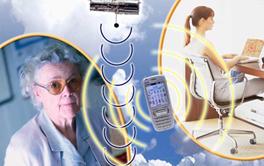USIC participates in European project of support to the elderly and develops project with SEGALAB
The kick-off meeting of the CAALYX project took place last 15th and 16th of January, in Valladolid, where Artur Rocha, Ângelo Martins and Ricardo Henriques of the Information and Communication Unit (USIC) participated.
25th January 2007
The CAALYX - Complete Ambient Assisted Living Experiment - is a two-year project and is financed by EU’s Sixth Framework Programme for Research and Development, as a part of IST, specifically the Ambient Assisted Living area.
But what is Ambient Assisted Living (AAL)? It is known that Europe is about to go through a very important social change due to a demographic transition never occurred before: the relation between old people and the total population is increasing gradually while the percentage of the younger people is decreasing, particularly when it comes to active population. The AAL approach is a variation of Ambient Intelligence oriented towards a specific group of users, providing some answers to the challenges created by this demographic situation. AAL intends to extend the time old people can live independently, increasing their self-sufficiency and self-confidence, offering remote monitoring and care, 24 hours a day.
The main objective is to develop a light and wearable device, capable of measuring vital signs which are specific to the person, detecting falls and accidents and automatically communicating them in real time, in case of emergency, whether the person is inside or outside. The information transmitted will include the geographical location as well as essential data, in a way as to initiate a quick and appropriate response.
CAALYX will integrate mobile geo-positioning as well as ‘plug and play’ technologies of dynamic wireless networks, and it will develop algorithms of detection of falls and identification of patterns of biological signs. The integration of new non-intrusive sensors for detection of falls and for a stricter positioning will be the solution to many of the difficulties identified in the use of these approaches.
The monitoring device for the care taker involves devices that range from a mobile phone to a more complex system, making it possible to create an integrated system of cares for groups of senior citizens. When the person is home, the system will be complemented with other devices like cameras and TV, in a way as to enable the establishment of personal services in an effective way.
The system will be tested in a feasibility study integrated in a social programme for old people, with feedback from real final users.
Besides INESC Porto, the partnership includes Telefónica Investigación y Desarrollo – TID, Spain (general coordinator), Corscience GmbH & Co KG, Germany; COOSS Marche Onlus-COOSS, Italy; Synkronix Ltd. – SYNK, United Kingdom; University of Plymouth-UPLY, United Kingdom; University of Limerick-ULIM, Ireland and Guy’s and St Thomas’ Hospital NHS-GST, United Kingdom.
The participation of INESC Porto through USIC is focused on the systems associated to positioning, regarding whether portable devices or management systems, with special emphasis on interoperability of geo-referenced information. INESC Porto is the technical coordinator of this project and it is the leader of the WP5 work package – System Implementation.
The original basis of this partnership is MEDSI - a European project about the protection of critical infrastructures - where USIC’s work was unanimously praised.
For further information, you can go to the project’s website – http://caalyx.eu/
BIP January 2007


